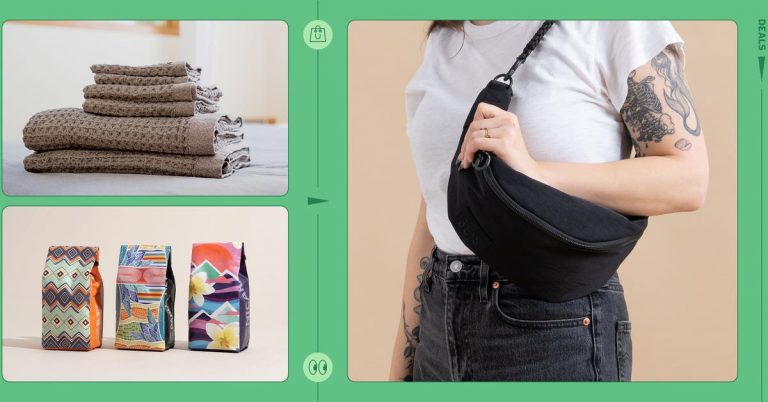How To Set a Gorgeous Table Without Breaking the Bank
Entering into this project as they did, with only the loosest sense of what they wanted, it made sense for both Michael and Lesley to begin by looking in person. The first step to finding great stuff is finding great places to look — that aren’t overpriced, picked over, or just not up your alley taste-wise. That’s why both writers also tend to prefer thrift stores and antique malls over more curated antique or vintage stores, though they looked in a mix of both. Michael has found some of his best treasures either in thrift stores in wealthy neighborhoods or outside of the city, where items tend to be cheaper.

Lesley, who did all of her shopping while visiting family in Houston, suggests using search terms like “charity thrift,” “charity resale,” “antique mall,” and “consignment” to find the best options in your area. Also, she says, “keep an eye out for signs for tag sales, yard sales, et cetera. You’re bound to see a few while driving around different neighborhoods for estate sales.”
“It’s more fun to shop in person because of all the unexpected finds. I prefer it for tabletop items especially because it allows you to touch the items and really inspect them up close,” says Michael. Lesley agrees: “I need to touch and hold things before I know I can live with them.”
Get familiar with estate sales
Both Michael and Lesley use EstateSales.net to find estate sales locally. Since an estate sale usually includes the belongings of just one person (or a family), and often takes place in that person’s home, it’s a good way to get a feel (real or imagined) for the history of an item, and to see how someone else might have used and styled it. It’s also your best chance of finding a complete set of something like dinnerware or even multiple sets with a cohesive style.
When browsing the listings, Lesley recommends checking the photos to judge whether the sale has the type of things you’re looking for. Don’t focus on specific items, she says, “but more on the overall style or aesthetic of the items. Remember that someone curated this collection over the course of a lifetime. So even if you don’t see something specific in the photos, it’s still worth a look if the overall vibe resonates with you.”
Come prepared
Although he approaches shopping for tableware with an open mind, Michael keeps a couple of small tools in his pocket to make sure he’s buying the right thing: “I like to bring a measuring tape if I’m uncertain about the size of items that will fit in my cupboards. It can also be helpful to bring a small magnifying glass or jeweler’s loupe for reading maker’s marks — like on the underside of silverware, which is often finely printed.” If you don’t have a magnifier, Lesley says your phone’s camera can also work in a pinch. “Just snap a pic and enlarge the image.”

Those maker’s marks can be important to understand both durability and provenance. Solid stainless steel or silver flatware will also last longer than sets with plastic, resin, or riveted handles, which Michael has found can fade, crack, or loosen over time (resin, he notes, seems to be the most durable of these materials but can still fade over time when it’s run through the dishwasher). That’s why Michael recommends that you “stick to 18/8 and 18/10 stainless steel. This is the most durable type of flatware, and it’s resistant to rust and won’t scratch as easily, though it will still develop some patina.” Many sets will have that number stamped on the back of the handle, though older stainless steel pieces or European utensils may say “Inox,” which is also stainless steel. You can find that by looking closely at the handle.
For the best deals, exercise patience and bring cash
You might think estate sales are an “early bird gets the worm” situation: Show up first thing on the first day to get access to the best treasures. And sure, you might want to show up early if you have your eye on something specific. But otherwise, Lesley says, “You can save even more money if you wait until the second or third day of the sale, when items are usually reduced up to 70% off (in my personal experience). Sure, you don’t have as much selection. But there are still some treasures to be found.”
She took this approach while visiting family in Houston: “I arrived on the second-to-last day, hoping for some discounts, and I was in luck — everything was 40% off. Yes, the place was picked over. But as soon as I got to the kitchen, these Wedgwood beauties were front and center on the countertop. After the 40% off, they came out to $6 apiece. And they’re pretty perfect, no crazing or chips. I’m not so much a Wedgwood girlie, but I do love their cream and off-white pieces. The warmth of the color combined with bone china’s milky translucence puts me in a trance.”

The same tactic can work when shopping in some stores, says Lesley. “Some thrift shops reduce the price of their inventory after it’s been in the store a certain amount of time. Usually the price tag will have a list of dates with the corresponding reduced prices next to them. Again, it’s a gamble to wait. But you could score.”
And whether or not your find has been discounted, don’t be afraid to negotiate. “Bargaining or haggling is normal in many cases,” says Lesley. “If you’re buying a bunch of items from an estate or tag sale, you can always ask them to knock a few bucks off the total down to an even number. Also, use cash whenever possible. Sellers prefer it, and it gives you more bargaining power.
The one exception: “I’d never dream of haggling at a charity thrift shop, as those proceeds are going to a cause.”
Use online listings for a price check
When you find something intriguing, it’s often helpful to whip out your phone to cross-check the price against online listings. But don’t necessarily trust the first listing you see. “Be cautious of pricing on sites like eBay or Etsy,” says Michael. “While they can be helpful for figuring out ballpark pricing, it’s often arbitrary. It’s hard to know if a seller has done their research.”
Instead, both he and Lesley rely on Replacements, LTD, which sells replacements for a wide range of vintage and contemporary tableware, for a sense of the going price. Replacements also allows you to search by photo rather than keyword, which is especially handy for on-the-fly research.
Michael also uses the Internet Archive to search for digitized versions of old value and identification guides for tableware and collectibles, “which is handy for determining the age and price of items. You can also learn about their history.”
When shopping for sets, don’t be afraid of odd numbers and mismatching
When buying new, it’s common to find tableware sold in even numbers (sets of four, six, eight, and so forth.) Shopping secondhand, numbers are predictably a little more all over the place. But an odd number of dishes doesn’t need to be a dealbreaker.
Michael, for example, fell in love with a mismatched set of mid-century Russell Wright American Modern Steubenville dishes while shopping in an antique mall in Maryland on vacation. “I recognized them right away since they were among the best-selling dinnerware of all time (other pieces from this collection are in The Met and MoMA), and I was particularly smitten with the pink and gray colors, which I thought would look great as a mixed set.”
Even with mixing colors, the set was incomplete, but, “While standing in the store I did a quick search on eBay to see if I could easily find the remaining plates to create four place settings. Since it seemed plentiful and reasonably priced, I pulled the trigger and got a few pieces: three salad plates, two bread and butter plates, and one dinner plate.”

When he returned home, Michael was met with ready success in completing the set, finding everything on eBay except one gray salad plate.
That plate proved pretty rare — a gamble you may take when putting together a set piecemeal — and was selling for $50 on Replacements, LTD. But eventually, patience and persistence paid off: “I kept going back to eBay just to see if it would pop up, and it did! I got two salad plates for about $20.”

If you do find yourself trying to complete a set via Etsy or eBay, Michael recommends a two-pronged approach for your search: “Try to be as specific as possible (for example, ‘Russell Wright Steubenville American Modern dinner plates’). But it’s also good to do broader searches (such as, ‘Russell Wright American Modern’), as some items will be sold in larger sets and/or the seller will list it with fewer specifics.”
Michael was also tempted by a set of five drinking glasses, each featuring a different bird and figured the extra glass wouldn’t hurt: “If one breaks, you still have a set of four.” But ultimately he settled on a set of five 1939 Hazel Atlas cobalt blue glasses with sailboats on them, which felt more unique than the bird ones. (However, Michael recommends caution when buying colored glass, because it’s common for modern glassware to get its color from a coating that can wear off. “This won’t be an issue for antique or vintage glass,” he says, “but for modern glasses that make their way into thrift stores. Look for areas when the coating may have worn away, or do a scratch test in an inconspicuous area with a key to see if the coating scrapes off.”)

Don’t be afraid to mix styles
Not everything needs to match perfectly, as long as you have an eye toward unifying details.
Lesley had more luck finding most of the items she wanted in sets of four or more. But she was determined to include a set of coffee cups and saucers in her set. (“To anyone who says that these are impractical for everyday use, I say that I drink my coffee every morning from a dainty Royal Daulton cup that’s a part of my great-grandmother’s set of wedding china. Give it a try! It’s a great way to start your day,” she says.) But she struggled to find ones she liked within her budget. So ultimately, she took a mix-and-match approach, choosing two cups with a wheat pattern from Lenox and two with a floral pattern from Tirschenruth Bavaria.
“I love mixing bright white and cream together,” says Lesley. “After I found the Wedgwood cream plates, the Fire King bowls I bought were white. So I set out to find cream-glazed cups and saucers to tie the whole setting together. I found those and a set of bread and butter plates all at a single stall in an antiques mall in Houston. Oh, the sigh of relief I let out because they’re perfect with the setting and round it out so beautifully. The gold laurel pattern on the plates ties in with the rest of the dishware (including a gold-rimmed glass salad serving set), and the pink rims add color to a mostly neutral table setting.”






